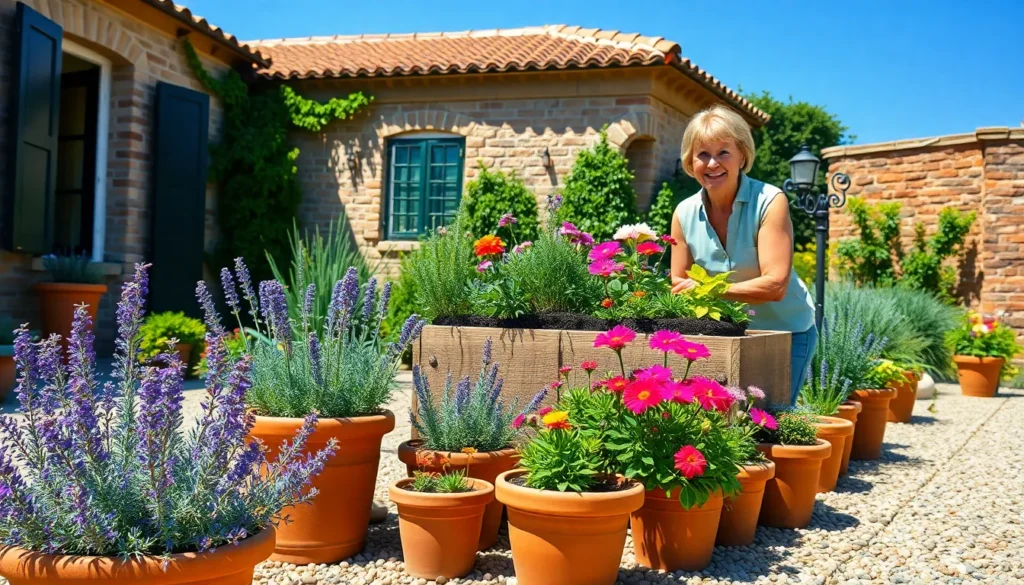Transforming a courtyard into a stunning garden oasis doesn’t require vast spaces or unlimited budgets – it just needs the right vision and creative approach. We’ve discovered that even the smallest outdoor areas can become breathtaking retreats when you know which design principles to apply and which plants thrive in enclosed spaces.
Whether you’re working with a modern urban courtyard, a traditional Mediterranean-style space, or a cozy cottage garden nook, we’ll show you how to maximize every square foot. From vertical gardening answers that draw the eye upward to clever water features that create soothing ambiance, there’s no shortage of possibilities.
The best courtyard gardens combine functionality with beauty, creating intimate spaces perfect for morning coffee, evening relaxation, or entertaining guests. We’ll explore practical ideas that work for various climates, budgets, and skill levels – because everyone deserves their own private garden sanctuary.
Create a Mediterranean Oasis With Drought-Tolerant Plants
Mediterranean gardens bring effortless elegance to courtyards while requiring minimal water and maintenance. We’ll transform your space into a sun-soaked retreat that thrives in dry conditions.
Choose Lavender and Rosemary for Fragrance
Lavender creates an instant Mediterranean atmosphere with its purple spikes and intoxicating scent that fills the air on warm evenings. Plant English lavender (Lavandula angustifolia) in sunny spots where it’ll bloom from late spring through summer, attracting beneficial pollinators to your courtyard. We recommend spacing plants 18-24 inches apart to allow proper air circulation and prevent fungal issues.
Rosemary serves double duty as both an aromatic herb and attractive evergreen shrub that stays green year-round. Choose upright varieties like ‘Tuscan Blue’ for vertical interest or trailing types such as ‘Prostratus’ to cascade over walls and containers. Position rosemary plants near seating areas where you can easily brush against the foliage to release their pine-like fragrance.
Combine these herbs with other Mediterranean staples like thyme, oregano, and sage to create fragrant herb clusters throughout your courtyard. Group plants with similar water needs together to simplify maintenance and create natural-looking plant communities.
Install Gravel Pathways Between Plant Beds
Gravel pathways define planting areas while providing excellent drainage that Mediterranean plants crave. We suggest using decomposed granite or pea gravel in warm tones like buff, tan, or terracotta to complement the Mediterranean color palette. Create pathways 3-4 feet wide to allow comfortable passage and wheelchair accessibility if needed.
Install industry fabric beneath the gravel to suppress weeds while allowing water to penetrate the soil below. Edge pathways with natural stone, brick, or metal strips to contain the gravel and create clean lines between planted areas and walkways. This professional finish prevents gravel from migrating into plant beds during heavy rains.
Consider adding stepping stones made from flagstone or concrete pavers within gravel paths to create interesting texture variations. Space stones 18-24 inches apart for comfortable walking stride and set them slightly above gravel level to prevent tripping hazards.
Add Terra Cotta Pots for Authentic Appeal
Terra cotta containers instantly evoke Mediterranean charm while providing excellent growing conditions for drought-tolerant plants. Choose pots in various sizes from small 8-inch planters to large 24-inch statement pieces to create visual depth and accommodate different plant types. We prefer unglazed terra cotta because it allows soil to breathe and excess moisture to evaporate naturally.
Group containers in odd numbers like clusters of three or five to create pleasing arrangements that feel natural rather than forced. Place larger pots as anchor points near seating areas or courtyard corners, then surround them with smaller containers filled with succulents, herbs, or seasonal flowers.
Select plants that complement terra cotta’s warm orange tones such as silver-leafed artemisia, blue-flowered plumbago, or deep purple salvias. Fill pots with well-draining potting mix amended with perlite or coarse sand to prevent waterlogged roots that can kill Mediterranean plants during cooler months.
Design a Modern Minimalist Courtyard Space
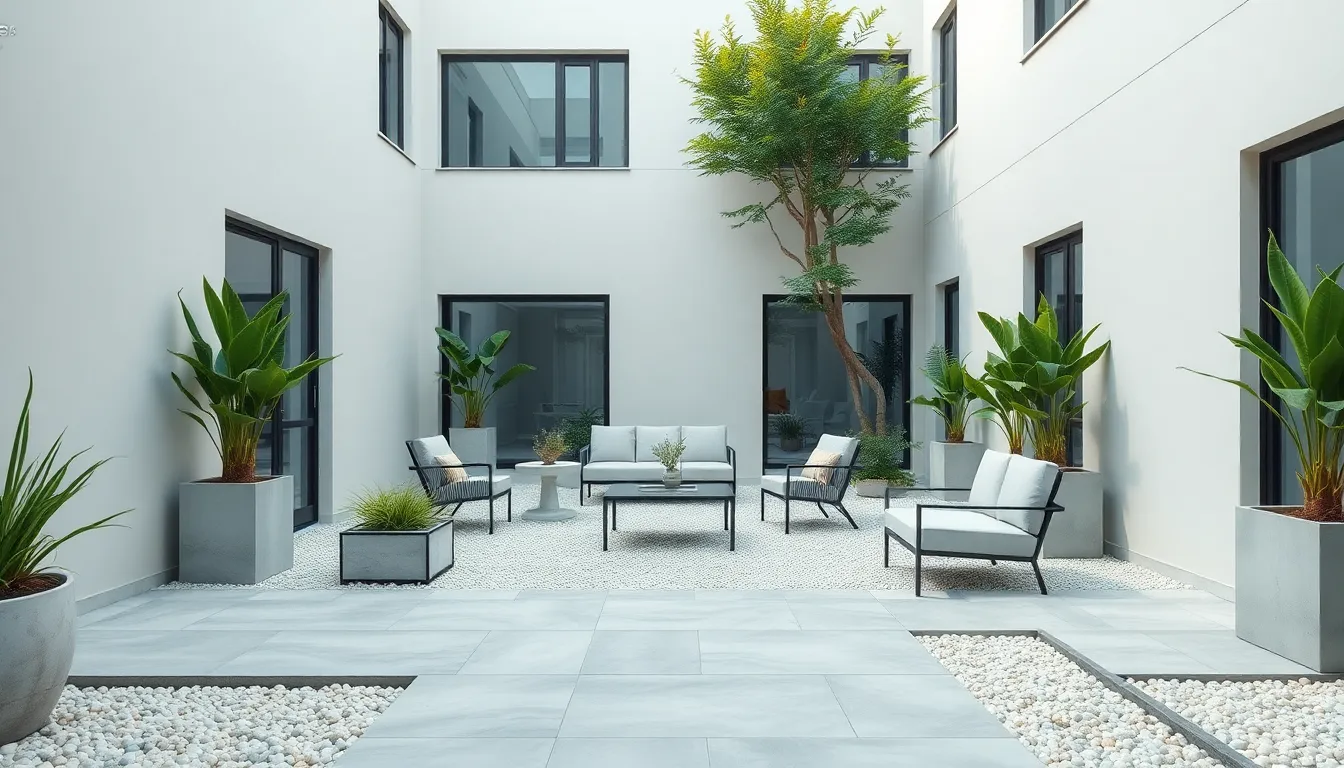
Transitioning from the Mediterranean style’s rich textures and warm colors, we can explore a completely different aesthetic approach. Modern minimalist design emphasizes simplicity and restraint to create peaceful outdoor retreats that maximize visual impact through carefully curated elements.
Select Clean-Lined Planters and Furniture
Clean-lined planters form the foundation of minimalist courtyard design by providing structure without visual clutter. We recommend choosing rectangular concrete planters, sleek metal containers, and simple wooden boxes that complement your space’s architectural lines. Furniture selection should prioritize low-profile pieces that maintain open sightlines throughout the courtyard.
Materials like powder-coated steel, teak wood, and cast concrete work exceptionally well in neutral tones such as charcoal gray, warm white, and natural wood finishes. Streamlined benches, geometric side tables, and angular lounge chairs create functional seating areas without overwhelming the space. These pieces should feel intentional rather than decorative, serving exact purposes while contributing to the overall aesthetic harmony.
Incorporate Geometric Hardscaping Elements
Geometric hardscaping elements add architectural interest while reinforcing the minimalist theme through structured patterns and clean transitions. Smooth concrete pathways create clear circulation routes that guide movement through your courtyard space. Pale gravel beds provide textural contrast and excellent drainage while maintaining the restrained color palette.
Natural stone walkways arranged in linear or grid patterns enhance the modern aesthetic with their precise, intentional placement. Rectangular raised planters, square seating areas, and linear water features further emphasize geometric forms. These hardscape elements should work together to create visual rhythm and spatial organization without competing for attention.
Use a Limited Color Palette for Cohesion
Limited color palettes dominated by neutral tones create the cohesive foundation that makes minimalist courtyards feel tranquil and deliberate. We suggest using white, gray, and beige as your primary colors, with green foliage serving as the main accent throughout the space. This restrained approach unifies furniture, planters, hardscaping, and plant selections into a harmonious whole.
Monochromatic schemes work particularly well, allowing subtle variations in texture and form to provide visual interest without disrupting the calm atmosphere. Consider how each element’s color contributes to the overall palette, ensuring that no single piece stands out dramatically from the unified composition. Natural materials in their unfinished states often provide the perfect neutral backdrop for this design approach.
Transform Your Space Into a Tropical Paradise

We’ll shift from minimalist design to embrace lush, dramatic plantings that transport you to an exotic getaway. This tropical transformation brings humidity, vibrant colors, and the soothing sounds of nature right to your doorstep.
Plant Large-Leafed Species for Drama
Palms create instant tropical ambiance with their graceful fronds and architectural silhouettes in courtyard settings. We recommend incorporating elephant ears and banana plants to establish bold focal points that command attention throughout your space.
Cannas deliver vibrant color bursts while adding substantial height and texture variations to your tropical design scheme. Bamboo species provide natural screening and gentle rustling sounds that enhance the exotic atmosphere we’re creating.
Container groupings maximize visual impact when you combine different large leafed varieties at varying heights and positions. We suggest placing these dramatic specimens strategically to frame seating areas and create natural privacy barriers.
Install a Water Feature for Humidity
Small ponds increase moisture levels naturally while providing the perfect backdrop for tropical plantings that thrive in humid conditions. We can incorporate fountains or waterfalls to create soothing ambient sounds that mask urban noise pollution.
Mosquito control becomes essential when introducing water elements to maintain comfortable outdoor living spaces year round. We recommend using mosquito repellent plants or biological treatments to keep these features enjoyable without chemical intervention.
Circulation pumps prevent stagnation and ensure your water features remain healthy ecosystems that support both plants and beneficial wildlife. Lighting systems can illuminate these features during evening hours to extend your tropical paradise experience.
Create Layered Plantings at Different Heights
Containers of varying sizes allow us to establish multiple planting levels that create depth and visual interest in compact spaces. We position larger specimens as backdrop elements while using medium and small containers for foreground detail.
Vertical gardening techniques maximize growing space by incorporating trellises and wall mounted planters throughout your courtyard design. Living walls can support climbing tropical vines that soften hard surfaces and increase overall greenery coverage.
Understory plantings fill gaps between larger specimens while providing color continuity and textural contrast at ground level. We select shade tolerant tropical species that complement overhead canopy plants while thriving in filtered light conditions.
Build Vertical Gardens to Maximize Small Spaces
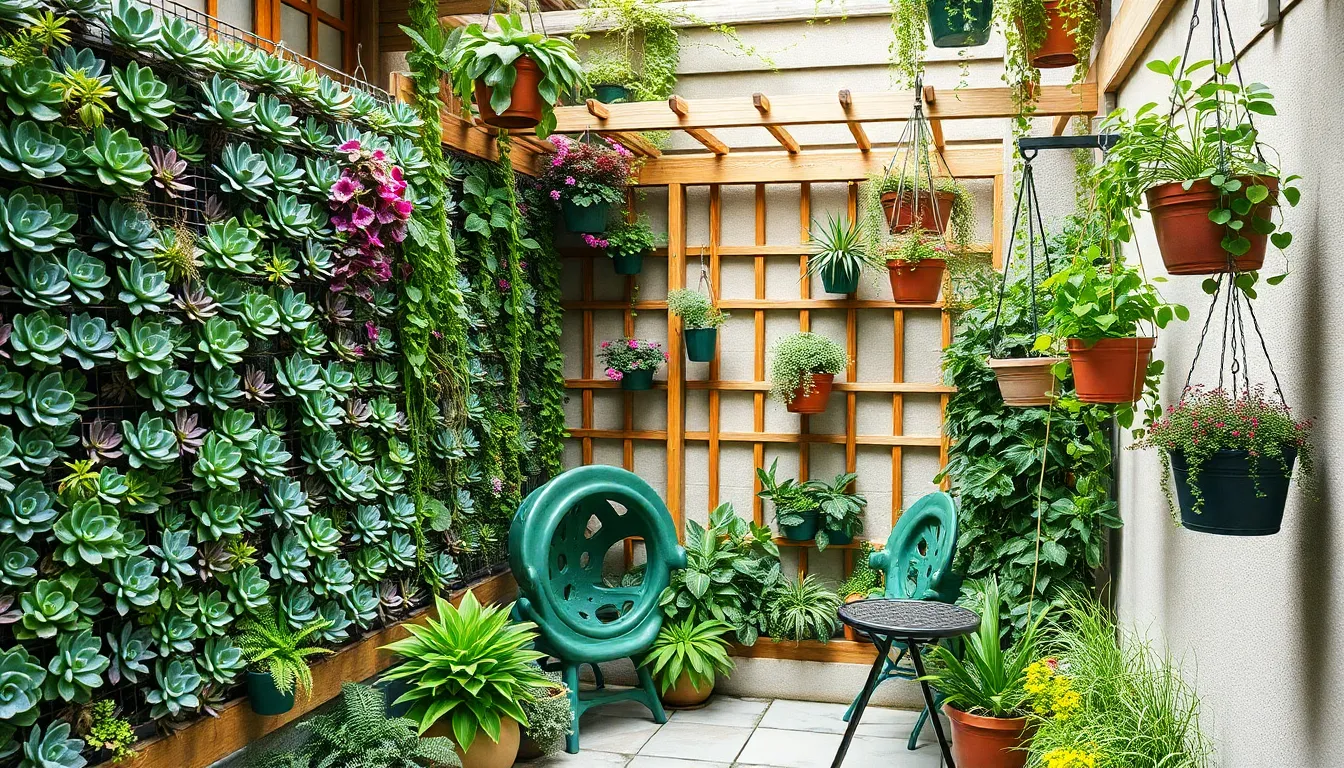
Vertical gardening transforms limited courtyard areas into lush green spaces by utilizing wall surfaces and height. We’ll explore practical answers that add greenery without consuming valuable floor space.
Install Living Walls With Modular Systems
Modular systems offer the easiest approach to creating stunning living walls in courtyard gardens. We recommend these pre-designed units because they come with built-in irrigation and drainage systems that simplify maintenance dramatically.
Installing modular vertical garden panels takes just a few hours and requires minimal DIY skills. These systems feature individual planting pockets that accommodate various plant types, from succulents to ferns. Most manufacturers provide mounting hardware designed for different wall materials including brick, concrete, and wood siding.
Benefits of modular living walls include:
- Easy plant replacement without disturbing neighboring plants
- Built-in water distribution systems
- Lightweight construction suitable for most wall types
- Professional appearance with minimal effort
We suggest starting with drought-tolerant plants like sedums or air plants for low-maintenance installations. These systems work particularly well on blank walls that receive partial sunlight throughout the day.
Use Trellises for Climbing Plants
Trellises create dramatic vertical displays while supporting vigorous climbing plants in courtyard gardens. We find wooden or metal trellises work best when secured properly to walls or freestanding structures.
Climbing plants like clematis, ivy, and jasmine transform plain trellises into living privacy screens within months. These plants naturally grow upward, making them perfect for small spaces where ground area is precious. Popular trellis materials include cedar wood for natural aesthetics and powder-coated steel for modern designs.
Installing trellises requires:
- Sturdy mounting brackets rated for plant weight
- Proper spacing from walls for air circulation
- Regular pruning to maintain desired coverage
- Seasonal plant care exact to climbing varieties
We recommend positioning trellises to receive morning sun and afternoon shade for optimal plant health. Annual vines like morning glories provide quick coverage, while perennial climbers offer long-term structure and beauty.
Hang Planters at Varying Levels
Suspended planters create layered visual interest while maximizing growing space in courtyard gardens. We achieve this effect by hanging containers at different heights using ceiling hooks, wall brackets, and freestanding structures.
Varying planter heights draws the eye upward and makes small courtyards feel more spacious and ever-changing. This technique works especially well with trailing plants like pothos, string of pearls, and cascading petunias that create natural curtains of greenery.
Successful hanging planter arrangements include:
- Heavy-duty mounting hardware rated for saturated soil weight
- Proper drainage to prevent water damage below
- Easy-access positioning for regular maintenance
- Wind-resistant placement in exposed areas
We suggest grouping planters in odd numbers at staggered heights for the most appealing visual impact. Lightweight containers made from fiberglass or resin work best for suspended installations, reducing stress on mounting systems while providing adequate root space for healthy plant growth.
Establish Defined Garden Zones for Multiple Uses
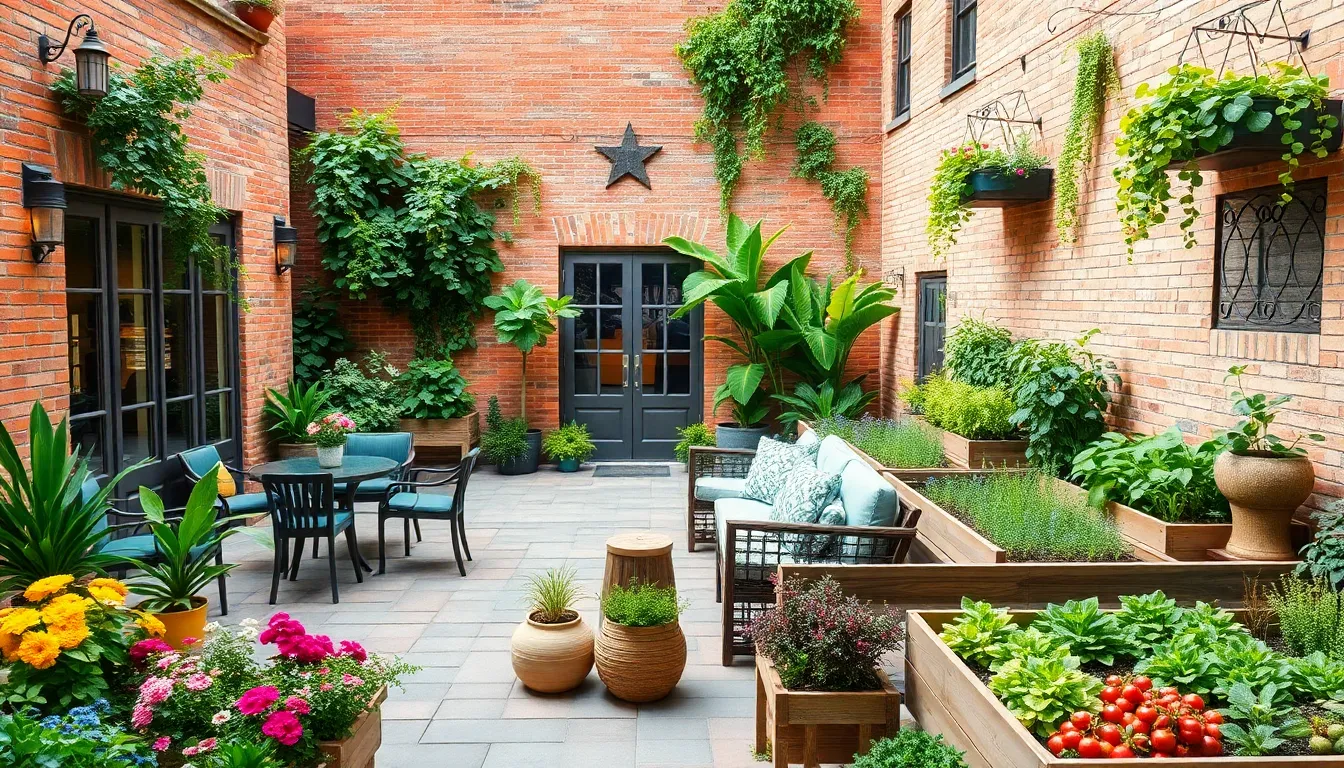
Transforming your courtyard into distinct functional areas creates a versatile outdoor space that serves multiple purposes. We recommend using geometric layouts with squares or rectangles to organize small, regular-shaped plots as distinct zones, while clear boundaries like raised garden beds or low walls visually divide the space while maintaining natural flow.
Create a Dining Area With Outdoor Furniture
Setting up a dedicated dining zone transforms your courtyard into an ideal space for hosting gatherings and enjoying outdoor meals. We suggest choosing compact, stylish furnishings that match your interior aesthetic to create a seamless transition from inside to outside. Positioning the dining area near your home facilitates easy access and encourages frequent use throughout the year.
Consider selecting weather-resistant materials that complement your courtyard’s overall design theme. Tables with built-in storage provide additional functionality in smaller spaces, while stackable chairs maximize flexibility when entertaining different group sizes. Strategic placement near power sources enables easy setup of outdoor lighting or heating elements for extended evening use.
Design a Reading Nook With Comfortable Seating
Creating a peaceful reading corner requires selecting a quiet area that’s preferably shaded by architectural plants or trees. We recommend using cushioned chairs or a plush bench surrounded by greenery to provide privacy and tranquility for uninterrupted relaxation. Integrating soft lighting, such as LED lights under benches or along pathways, enhances usability during evening hours.
Position your reading nook away from high-traffic areas to maintain a sense of seclusion and calm. Adding side tables for books and beverages increases functionality, while weather-resistant cushions and throws ensure comfort across different seasons. Privacy screens created with trellises or tall planters help establish boundaries without completely closing off the space.
Designate Growing Space for Herbs and Vegetables
Establishing a productive growing area maximizes your courtyard’s potential for fresh food production. We suggest using raised beds or containers as practical choices for small areas, offering superior control over soil quality and simplified maintenance routines. Positioning this zone near a water source and close to your kitchen increases accessibility for daily harvesting and care.
Mixing edible plants with ornamental varieties creates visual interest while blurring traditional garden boundaries. Vertical growing systems like wall-mounted planters or tiered container arrangements maximize production in limited square footage. Grouping plants with similar water and sunlight requirements streamlines maintenance while ensuring optimal growing conditions for your herbs and vegetables.
Incorporate Water Elements for Tranquility
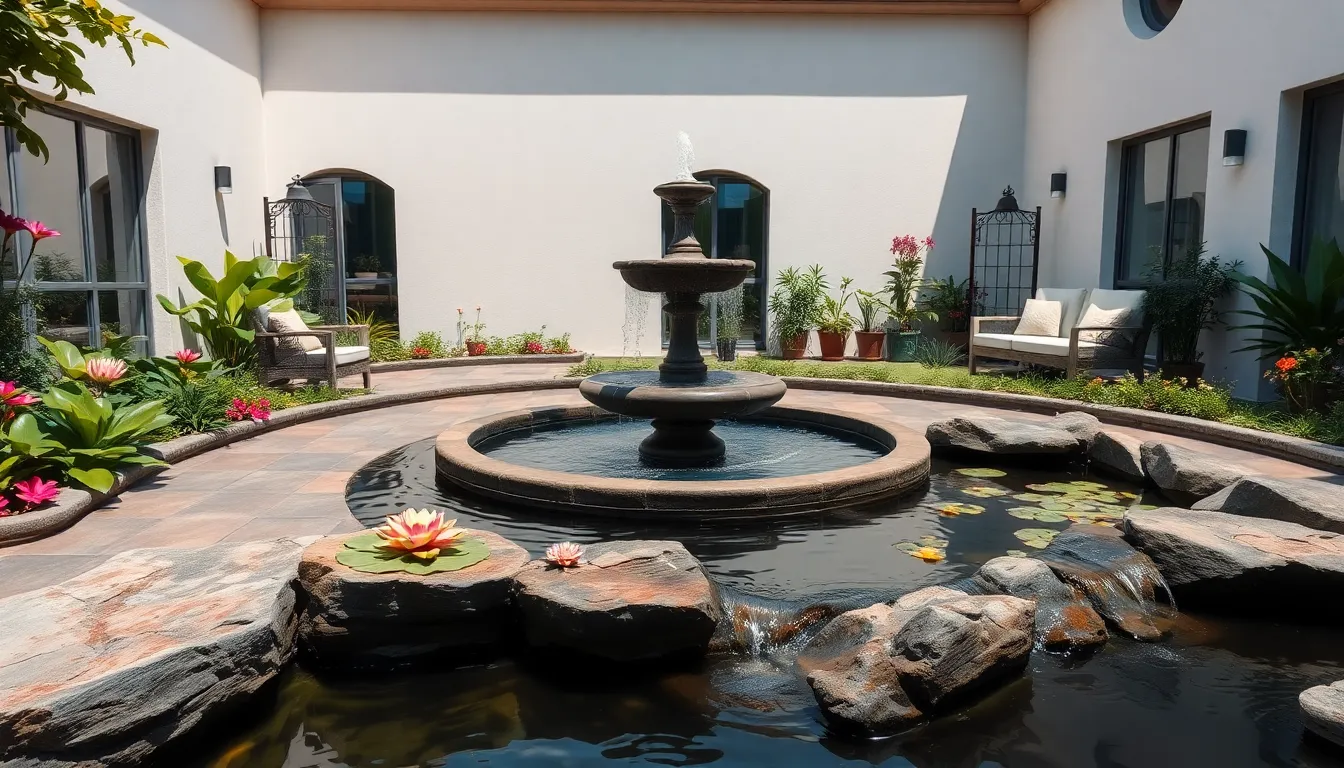
Water features transform courtyard gardens into serene retreats that engage our senses and create a natural focal point. These elements add movement, sound, and visual interest while supporting beneficial wildlife in our outdoor spaces.
Install a Central Fountain as a Focal Point
Central fountains serve as striking visual centerpieces that draw attention and anchor our courtyard design. Classical stone fountains offer timeless elegance, while modern minimalist designs complement contemporary aesthetics with clean lines and geometric shapes. Sound and movement from flowing water create a tranquil ambiance that masks urban noise and promotes relaxation.
Surrounding our fountain with seating areas or planted borders transforms it into a natural gathering spot for entertaining. Strategic placement allows the fountain to be viewed from multiple angles throughout the courtyard. Lighting features can extend the fountain’s visual impact into evening hours, creating dramatic shadows and reflections.
Add a Small Pond With Aquatic Plants
Small ponds introduce natural water habitats that encourage biodiversity in our courtyard gardens. Aquatic plants like water lilies add vibrant color and interesting textures while providing shelter for beneficial insects and small wildlife. Naturalistic rock edges help ponds blend organically into garden settings, creating seamless transitions between water and planted areas.
Reflection of light and sky in pond surfaces creates restful visual effects that change throughout the day. Oxygenating plants maintain water clarity and network health, while floating varieties provide natural beauty without requiring soil. Strategic placement near seating areas allows us to enjoy close observation of aquatic life and seasonal plant changes.
Create a Rain Garden for Natural Drainage
Rain gardens capture and filter runoff water naturally through carefully selected native plantings that thrive in varying moisture conditions. This sustainable approach manages drainage issues while adding seasonal interest and valuable wildlife habitat to our courtyard spaces. Integration with existing industry features creates functional beauty that serves multiple purposes.
Native plants in rain gardens require minimal maintenance once established and provide food sources for local pollinators and birds. Strategic placement in low lying areas or near downspouts maximizes water collection efficiency. Gravel borders and stepping stones allow access for maintenance while protecting plant roots from foot traffic.
Choose Low-Maintenance Plants for Easy Care

Building on the foundation of water features and defined zones, we’ll now focus on selecting plants that thrive with minimal intervention. Smart plant choices form the backbone of any successful courtyard garden design.
Select Native Species for Your Climate Zone
Native plants offer unmatched advantages for courtyard garden success since they’ve naturally adapted to local conditions over thousands of years. These species require significantly less water, fertilizer, and pest control compared to non-native alternatives, making them perfect for busy homeowners seeking beautiful yet manageable gardens.
Regional adaptation means native plants can withstand local temperature extremes, rainfall patterns, and soil conditions without constant intervention. Examples include purple coneflowers and black-eyed Susans in the Midwest, lavender and sage in Mediterranean climates, and palmetto and coontie in subtropical regions.
Wildlife benefits extend beyond maintenance ease, as native species provide essential food and habitat for local birds, butterflies, and beneficial insects. This natural network support creates a self-sustaining garden environment that requires minimal human intervention while supporting biodiversity.
Research your USDA hardiness zone before making plant selections, ensuring compatibility with your exact climate conditions. Local extension offices and native plant societies provide excellent resources for identifying the best species for your particular region and growing conditions.
Plant Perennials That Return Each Year
Perennial investments pay dividends season after season, eliminating the annual replanting cycle that burdens many gardeners. These hardy plants establish strong root systems during their first year, then return stronger and more beautiful each subsequent growing season.
Cost effectiveness becomes apparent quickly, as a single perennial purchase provides years of continuous blooms and foliage. Popular low-maintenance perennials include hostas for shaded areas, ornamental grasses like fountain grass, and flowering varieties such as daylilies and Russian sage.
Seasonal interest varies among perennial choices, with some offering spring blooms, others providing summer color, and many delivering striking fall foliage. Strategic selection ensures continuous visual appeal throughout the growing season without replanting efforts.
Establishment requirements are minimal once perennials settle into their permanent locations, typically requiring only basic watering during dry spells and occasional division every few years. This hands-off approach makes them ideal for courtyard gardens where space is limited but impact must be maximized.
Group Plants With Similar Water Requirements
Water-wise grouping strategies simplify irrigation while ensuring each plant receives optimal moisture levels for healthy growth. This approach, known as hydrozoning, prevents overwatering drought-tolerant species while ensuring water-loving plants receive adequate moisture.
Efficient watering systems become possible when plants with similar needs are clustered together, allowing for targeted irrigation that conserves water and reduces maintenance time. Examples include grouping succulents like echeveria and sedum in one area while placing moisture-loving ferns and begonias in another section.
Maintenance reduction occurs naturally when plants with compatible care requirements grow together, as fertilizing, pruning, and pest management can be addressed simultaneously. This grouping strategy also creates visually cohesive plant communities that appear more natural and intentional.
Microclimate optimization happens when we place high-water plants near water features or in naturally moist areas, while positioning drought-tolerant species in sunny, well-drained locations. This strategic placement works with natural conditions rather than fighting against them, resulting in healthier plants with less effort.
Add Lighting to Extend Evening Enjoyment
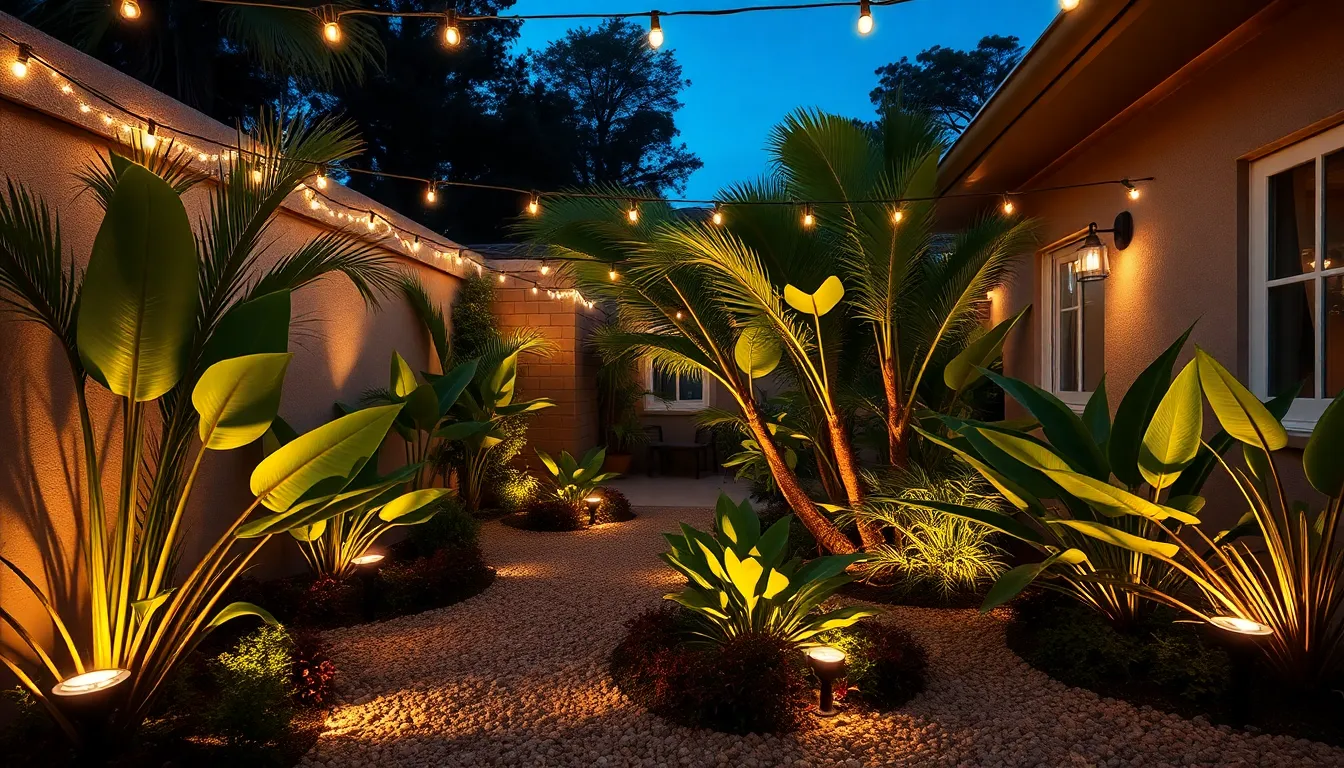
Transform your courtyard garden into an enchanting nighttime retreat with strategic lighting answers that enhance both function and atmosphere.
Install Solar Path Lights Along Walkways
Solar path lights offer the perfect combination of sustainability and low maintenance for courtyard garden illumination. Position these eco-friendly fixtures every 6-8 feet along your gravel pathways and geometric walkways to create safe navigation after dark. We recommend choosing models with warm LED bulbs that complement the ambient lighting from string installations above.
Most solar path lights automatically activate at dusk and provide 8-12 hours of continuous illumination on a full charge. Select styles that match your courtyard’s design aesthetic, whether you’re maintaining a minimalist approach with sleek metal fixtures or embracing Mediterranean charm with lantern-inspired designs. Place them strategically to highlight transitions between different garden zones and emphasize the boundaries of your defined spaces.
Hang String Lights for Ambient Atmosphere
String lights create magical ambiance that transforms your courtyard into an inviting evening destination. Suspend warm white LED strings between boundary walls, trellises, or overhead structures to establish a cozy canopy effect above seating areas. We suggest using dimmable options that allow you to adjust brightness levels for different occasions and moods.
Install permanent mounting points on walls or posts to support string light installations without damaging plants or structures. Choose weather-resistant bulbs rated for outdoor use that can withstand seasonal temperature changes and moisture. Layer multiple strands at varying heights to add depth and visual interest, creating an intimate atmosphere perfect for evening dining or relaxation in your reading nook.
Use Uplighting to Highlight Key Plants
Uplighting adds dramatic visual impact by showcasing your courtyard’s most impressive plantings and architectural features. Position low-voltage LED spotlights at the base of large-leafed tropical plants like palms or elephant ears to create stunning shadow patterns on walls and surfaces. We recommend using adjustable fixtures that allow you to fine-tune beam angles and intensity levels.
Focus uplighting on vertical garden installations and living walls to emphasize their texture and create living art after sunset. Install timers or smart controls to automate your uplighting system, ensuring consistent evening displays without manual operation. Choose fixtures with narrow beam spreads for accent lighting and wider spreads for general area illumination, creating layered lighting effects that enhance your courtyard’s depth and dimension.
Create Privacy With Strategic Plant Placement
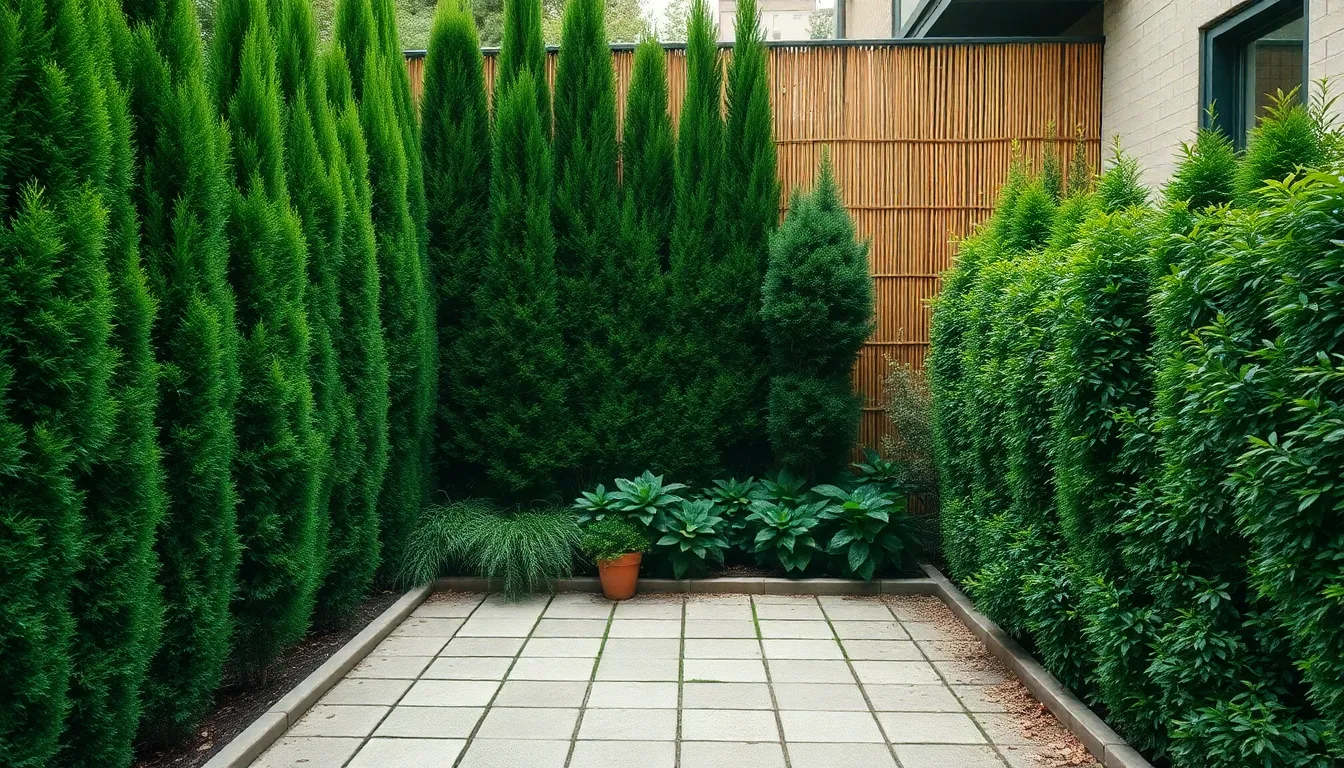
Strategic plant placement transforms our courtyard into a secluded retreat where we can relax without feeling exposed to neighbors. We’ll explore three effective approaches that use living elements to establish natural privacy barriers.
Install Tall Shrubs Along Property Lines
Tall shrubs create effective privacy screens when planted along property boundaries, blocking unwanted views from neighboring homes. We recommend selecting evergreen varieties like arborvitae or privet that maintain their foliage year-round, providing consistent coverage regardless of the season.
Position these shrubs 3-4 feet apart to ensure adequate coverage as they mature. Fast-growing options such as Leyland cypress or bamboo varieties can reach 6-8 feet within two to three years, establishing privacy more quickly than slower-growing alternatives.
Consider the mature size of each species when planning placement to avoid overcrowding. Layering different heights creates visual depth while maximizing privacy coverage throughout the courtyard space.
Use Bamboo Screens for Natural Barriers
Bamboo screens offer versatile privacy answers that complement various courtyard design styles while providing natural aesthetic appeal. We can install bamboo fencing panels or plant clumping bamboo varieties that won’t spread aggressively throughout the garden.
Running bamboo (like timber bamboo) creates dense screens quickly but requires root barriers to prevent unwanted spreading. Clumping varieties such as fountain bamboo or Buddha’s belly bamboo stay contained while still providing effective screening.
Position bamboo strategically to block exact sight lines while maintaining desired views of attractive garden areas. The natural texture and movement of bamboo leaves add visual interest and gentle sounds when breezes pass through the screening.
Plant Dense Hedges for Year-Round Coverage
Dense hedges provide consistent privacy coverage throughout all seasons when we select appropriate evergreen species for our climate zone. Boxwood, holly, and yew varieties create formal hedge lines that respond well to regular pruning and shaping.
Establish hedge plantings 18-24 inches apart for faster coverage, allowing individual plants to grow together into a continuous barrier. Regular trimming maintains the desired height and density while encouraging bushier growth patterns.
Mixed hedge plantings combine different species for enhanced visual interest and biodiversity. Alternating flowering shrubs like forsythia with evergreen varieties creates seasonal color changes while maintaining year-round privacy coverage.
Design Seasonal Interest Throughout the Year
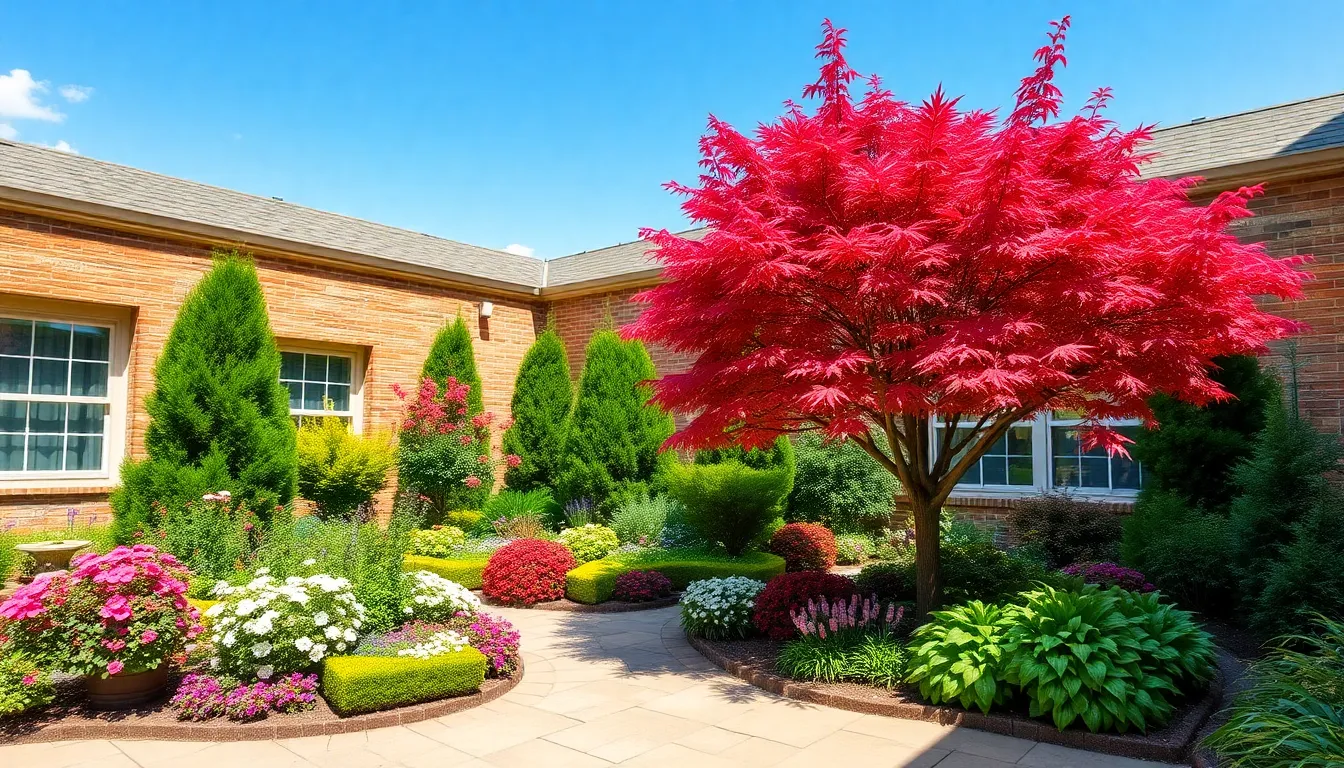
Creating a courtyard garden that captivates throughout every season requires strategic plant selection and timing. We’ll show you how to maintain continuous visual appeal from spring’s first blooms to winter’s structural beauty.
Choose Plants With Staggered Bloom Times
Planning your courtyard’s bloom schedule ensures continuous color and interest from spring through fall. We recommend arranging plants so each season features at least one group in bloom or displaying notable foliage. Spring flowering bulbs like tulips and crocus provide early season excitement, while summer perennials such as daylilies and coreopsis maintain vibrant displays during warmer months.
Autumn brings its own spectacular show with late season bloomers like asters and sedum that extend color well into fall. Combining these different bloom periods creates a ever-changing garden that never feels dormant or boring. Grouping plants with similar bloom times together amplifies their visual impact while ensuring your courtyard always has something beautiful to showcase.
Include Evergreens for Winter Structure
Evergreens form the backbone of year round courtyard appeal, providing essential greenery and form when deciduous plants lose their leaves. We suggest incorporating boxwood, arborvitae, or various conifers that anchor your design and offer attractive backdrops for other plants. These reliable performers maintain their structure through harsh winter months, preventing your courtyard from looking bare or lifeless.
Strategically placed evergreens create focal points and define spaces within your courtyard layout. Their consistent presence allows seasonal plants to shine while providing the stability your garden needs. Winter blooming plants like hellebores and witch hazel can complement your evergreen foundation, adding unexpected color during the coldest months.
Add Deciduous Trees for Fall Color
Deciduous trees bring ever-changing seasonal changes that transform your courtyard’s personality throughout the year. We recommend Japanese maples and paperbark maples for their stunning progression from bright green spring leaves to lush summer foliage, culminating in vibrant fall colors before winter dormancy. These trees create natural focal points while providing shade and vertical interest to your space.
Berry producing shrubs like holly contribute additional fall and winter appeal while supporting local wildlife populations. Their colorful fruits extend visual interest beyond traditional foliage displays. Combining deciduous trees with various shrubs at different heights creates layered plantings that maximize your courtyard’s seasonal drama and ecological value.
Conclusion
Creating your dream courtyard garden doesn’t require endless space or a massive budget—just thoughtful planning and creative vision. We’ve shown you how to transform any small outdoor area into a stunning retreat that reflects your personal style and meets your practical needs.
Whether you’re drawn to Mediterranean charm tropical lushness or minimalist elegance these design principles work together to maximize your space’s potential. The key lies in combining vertical elements water features strategic lighting and seasonal plantings to create depth and year-round interest.
Your courtyard can become the perfect outdoor sanctuary for relaxation entertaining and connecting with nature. Start with one or two ideas that resonate most with you and gradually build your garden oasis over time.
Frequently Asked Questions
How can I create a beautiful courtyard garden with limited space and budget?
Focus on vision and creativity rather than size or cost. Use vertical gardening techniques, choose multi-functional plants, and repurpose containers. Strategic placement of plants and water features can maximize impact. Consider drought-tolerant plants and group containers thoughtfully to create visual appeal without extensive investment.
What plants work best for a Mediterranean-style courtyard?
Choose drought-tolerant plants like lavender, rosemary, and other fragrant herbs that require minimal water and maintenance. These plants not only enhance the atmosphere but also attract beneficial pollinators. Use terra cotta pots for authentic charm and excellent growing conditions in dry climates.
How do I create a modern minimalist courtyard design?
Select clean-lined planters and low-profile furniture to maintain open sightlines. Use materials like powder-coated steel and teak wood in neutral tones. Incorporate geometric hardscaping elements such as smooth concrete pathways. Stick to a limited color palette with neutral tones for a tranquil, uncluttered atmosphere.
What elements make a tropical courtyard garden successful?
Plant large-leafed species like palms, elephant ears, and banana plants for bold focal points. Add cannas for vibrant color and height. Include water features like small ponds or fountains to increase humidity and provide soothing sounds. Use layered plantings at different heights to create depth and visual interest.
How can I maximize growing space in a small courtyard?
Utilize vertical gardening with modular living walls and trellises for climbing plants. Install hanging planters at varying heights to add visual interest. Use raised garden beds and container groupings strategically. These techniques help create lush, green environments while making the most of limited horizontal space.
What are the benefits of creating defined zones in my courtyard?
Defined zones create versatile outdoor spaces for multiple uses. Use geometric layouts and clear boundaries like raised beds to organize areas. Create dedicated spaces for dining, reading, and growing plants. This approach maximizes functionality while maintaining visual organization and flow throughout the courtyard.
How do water features enhance a courtyard garden?
Water features create tranquility and serve as striking focal points. Central fountains provide serene ambiance, while small ponds with aquatic plants promote biodiversity. Rain gardens manage drainage naturally through native plantings, offering seasonal beauty and wildlife habitat while contributing to sustainability.
What are the best low-maintenance plant choices for courtyards?
Choose native species that thrive in local conditions and require less water and maintenance. Plant perennials for long-term beauty and cost-effectiveness, as they return annually without replanting. Group plants with similar water requirements to optimize irrigation and reduce maintenance while promoting healthier growth.
How can I improve evening ambiance in my courtyard?
Install solar path lights along walkways for safe navigation and aesthetic appeal. Hang string lights above seating areas to create a cozy atmosphere. Use uplighting to highlight key plants and architectural features for dramatic visual impact, extending the courtyard’s usability into evening hours.
What’s the best way to create privacy in a small courtyard?
Install tall shrubs along property lines and use bamboo screens for natural barriers. Plant dense hedges for year-round coverage. Consider fast-growing options like Leyland cypress or bamboo varieties for quick privacy solutions. Layer different plant heights to enhance visual depth while creating seclusion.
How do I ensure year-round interest in my courtyard garden?
Select plants with staggered bloom times for continuous color from spring to fall. Include spring bulbs, summer perennials, and late-season bloomers. Plant evergreens for winter structure and deciduous trees for seasonal changes. This combination creates layered plantings that enhance beauty and ecological value throughout the year.

